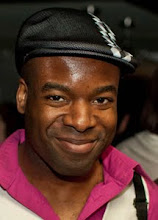As I returned home from my Zombie Walk photo shoot on Saturday afternoon, some of the thoughts running through my head before and during the shoot returned to me. For instance, upon seeing a SNAP Downtown Toronto photographer who had much better goods and an easy-going manner of co-operating with his subjects, I suddenly felt nervous and inadequate. Fortunately, one of the zombies provided encouragement by reminding me that since I was working for myself, no one could control my photos. After a few more minutes of dealing with those feelings, I went straight to work.
I'd also be interested in how the brain works as inspiration strikes. For example, check out this photo I took during a break at Nathan Phillips Square.

As you can see, the faces are a bit blurrier than the hand; this was done on purpose. I recall a weekly assignment at the Digital Photography School; the task was to show a photograph which was a mistake, but ended up becoming a keeper. The winner was a photo where the focus was meant to be on the singer's face, but the hand became the focal point instead.
With that picture in mind (perhaps unconsciously), every time a zombie reached out its hand toward my lens, I switched to aperture-priority mode in order to get the desired depth of field. In the above case, the effect wasn't as stark as I would have preferred, but it also isn't invisible. Besides, I was working at my lens' lowest possible f-stop number of 3.5.
As is often said, you have to use what you've got to get what you want.

No comments:
Post a Comment